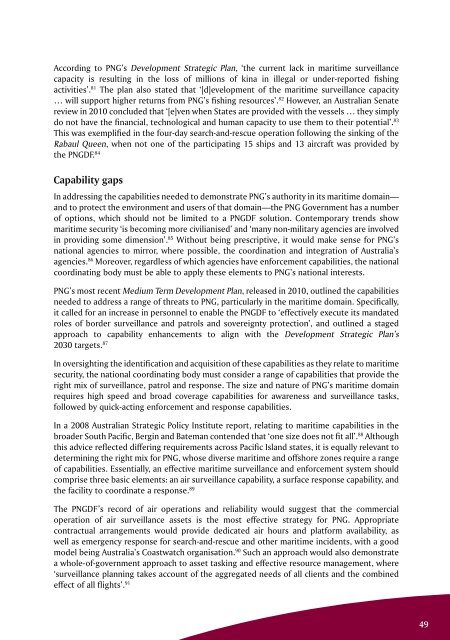ISSUE 191 : Jul/Aug - 2013 - Australian Defence Force Journal
ISSUE 191 : Jul/Aug - 2013 - Australian Defence Force Journal
ISSUE 191 : Jul/Aug - 2013 - Australian Defence Force Journal
- No tags were found...
You also want an ePaper? Increase the reach of your titles
YUMPU automatically turns print PDFs into web optimized ePapers that Google loves.
According to PNG’s Development Strategic Plan, ‘the current lack in maritime surveillance<br />
capacity is resulting in the loss of millions of kina in illegal or under-reported fishing<br />
activities’. 81 The plan also stated that ‘[d]evelopment of the maritime surveillance capacity<br />
… will support higher returns from PNG’s fishing resources’. 82 However, an <strong>Australian</strong> Senate<br />
review in 2010 concluded that ‘[e]ven when States are provided with the vessels … they simply<br />
do not have the financial, technological and human capacity to use them to their potential’. 83<br />
This was exemplified in the four-day search-and-rescue operation following the sinking of the<br />
Rabaul Queen, when not one of the participating 15 ships and 13 aircraft was provided by<br />
the PNGDF. 84<br />
Capability gaps<br />
In addressing the capabilities needed to demonstrate PNG’s authority in its maritime domain—<br />
and to protect the environment and users of that domain—the PNG Government has a number<br />
of options, which should not be limited to a PNGDF solution. Contemporary trends show<br />
maritime security ‘is becoming more civilianised’ and ‘many non-military agencies are involved<br />
in providing some dimension’. 85 Without being prescriptive, it would make sense for PNG’s<br />
national agencies to mirror, where possible, the coordination and integration of Australia’s<br />
agencies. 86 Moreover, regardless of which agencies have enforcement capabilities, the national<br />
coordinating body must be able to apply these elements to PNG’s national interests.<br />
PNG’s most recent Medium Term Development Plan, released in 2010, outlined the capabilities<br />
needed to address a range of threats to PNG, particularly in the maritime domain. Specifically,<br />
it called for an increase in personnel to enable the PNGDF to ‘effectively execute its mandated<br />
roles of border surveillance and patrols and sovereignty protection’, and outlined a staged<br />
approach to capability enhancements to align with the Development Strategic Plan’s<br />
2030 targets. 87<br />
In oversighting the identification and acquisition of these capabilities as they relate to maritime<br />
security, the national coordinating body must consider a range of capabilities that provide the<br />
right mix of surveillance, patrol and response. The size and nature of PNG’s maritime domain<br />
requires high speed and broad coverage capabilities for awareness and surveillance tasks,<br />
followed by quick-acting enforcement and response capabilities.<br />
In a 2008 <strong>Australian</strong> Strategic Policy Institute report, relating to maritime capabilities in the<br />
broader South Pacific, Bergin and Bateman contended that ‘one size does not fit all’. 88 Although<br />
this advice reflected differing requirements across Pacific Island states, it is equally relevant to<br />
determining the right mix for PNG, whose diverse maritime and offshore zones require a range<br />
of capabilities. Essentially, an effective maritime surveillance and enforcement system should<br />
comprise three basic elements: an air surveillance capability, a surface response capability, and<br />
the facility to coordinate a response. 89<br />
The PNGDF’s record of air operations and reliability would suggest that the commercial<br />
operation of air surveillance assets is the most effective strategy for PNG. Appropriate<br />
contractual arrangements would provide dedicated air hours and platform availability, as<br />
well as emergency response for search-and-rescue and other maritime incidents, with a good<br />
model being Australia’s Coastwatch organisation. 90 Such an approach would also demonstrate<br />
a whole-of-government approach to asset tasking and effective resource management, where<br />
‘surveillance planning takes account of the aggregated needs of all clients and the combined<br />
effect of all flights’. 91<br />
49

















